Making the Stirling Windows (Rab & Linda)
Stirling Castle, Royal Apartments
2011
Historic Scotland
Over 5,000 pieces of glass were cut and hand painted to make he heraldic medallions. Most of the pieces were each painted and fired at least three times. |  |
56 silver stained, golden barbelles were made for the shields of Mary of Guise (House of Bar). The drawing for the fish was influenced by the stained glass in St Nicholas de Port, and elsewhere in Lorraine. |  |
Over 300 tiny fleur-de-lys were cut and painted. Each piece of glass measures approximately 1cm square. | 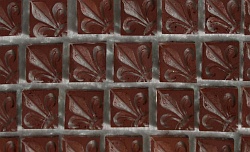 |
28 pices of glass depicting the "Arms of Jerusalem" were intricately decorated with scroll diaper work, strongly influenced by a tiny 16th century panel in the Ducal Palace in Nancy. | 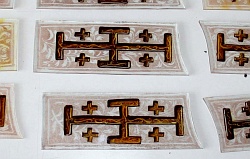 |
Rab designed, cut and painted all the decorative borders for the medallions. Each pair of border designs is different. They are stronly influenced by medallion borders in the Burrell Collection in Glasgow and the V&A in London, as well as the decorative borders in the original Stirling heads. (© Crown Copyright Historic Scotland) |  |
Linda designed, cut and painted all the inner heraldry and crownwork. Every part of the heraldry and crown-work was scrutinised and passed by the Lord Lyon's Office in Edinburgh. (© Crown Copyright Historic Scotland) | 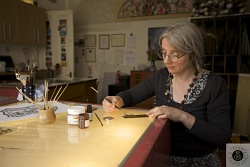 |
Each piece of glass was individually cut, painted and stained. Most of the glass was fired three times. We used two different kilns to fire the same paint (Debitus Brun XIIIeme mixed with clove bud oil). |  |
As paint was firing in the kiln, other paint was drying on top of the kiln. | 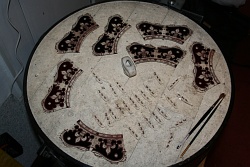 |
Rab worked to a similar routine to Linda, painting in batches, in a continuous painting / firing cycle which went on for months. (© Crown Copyright Historic Scotland) | 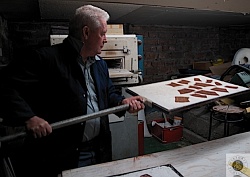 |
Full scale photocopies were made of each drawing prior to painting, in order to keep the original drawings in good condition. Each piece of glass was hand painted, freehand, on top of the photocopy. (© Crown Copyright Historic Scotland) | 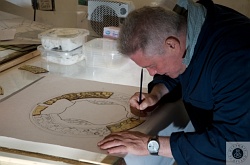 |
The six unicorns in the King's Inner Apartment took over two months of drawings and negotiations before final agreement was given by both Historic Scotland and the Lord Lyon's Office in Edinburgh. They are closely based on an original 16th century medallion in the Burrell Collection Archives. |  |
Both Rab and Linda worked day and night for over a year to complete the project. it was certainly not a "nine-to-five" job. During the last few months of the project we were both working 15 - 18 hour days, seven days a week. | 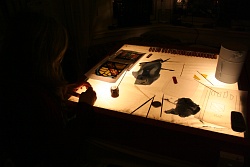 |
All of the leading of the medallions was done by Linda. |  |
The leading tollerances were very small, using specially made 1/8" round lead for each of the heraldic quarterings, and gradually moving out, to a wider 1/4" lead at the perimeter. (© Crown Copyright Historic Scotland) |  |
Twenty red Lions Rampant were prepared by Linda's neice, Jacqueline Fraser during a school work-placement week. They were then etched in Hydrofluoric Acid by Linda. | 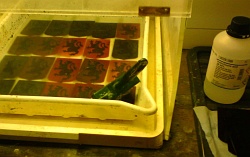 |
Like Rab's work, each shield was leaded on top of a photocopy of the original drawing. | 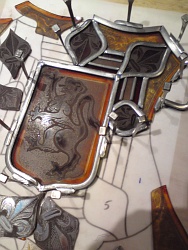 |
After leading, each panel was waterproofed and sealed "cement", using a toothbrush. Talc was then used to dry the cement before polishing. | 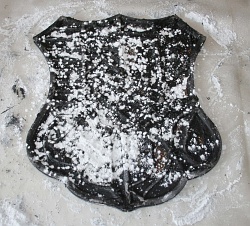 |
The complexity and detail of each panel can be seen best close up. | 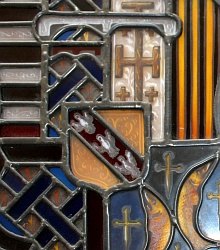 |
Each of the King's rooms have unique diaper-work in the yellow border of the shield. This pattern work is for the King's Inner and is derived from the diaper-work in a 16th century medallion in the V&A in London. | 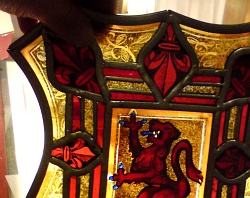 |
At one point, around Christmas 2010, there were 54 heraldic shields in the studio, waiting for completion. |  |
Each piece of every pair of medallion surrounds was checked on the photocopy of the drawing, prior to being boxed and labled for each specific location. | 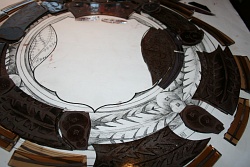 |
Once each set of medallion surrounds were ready, the glass was brought over from Rab's studio, to Linda's, for leading. |  |
Unusually, each medallion was leaded from the inside, out. |  |
As each medallion was completed, a quick photograph was taken by Linda, and texted to Rab in his studio for comment. Rab, by this point, was leading up plain quarry glazing for the lower halves of the upper panels. | 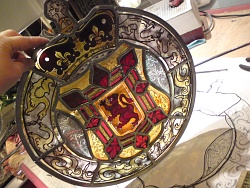 |
The medallions were then divided up eaqually between Rab and Linda, and leaded into the decorative quarry surround. | 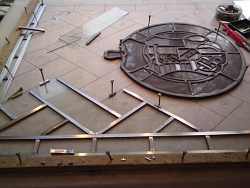 |
All of the medallions were leaded into the quarry work by Rab and Linda. However, time became increasingly tight towards the end of the project. We are indebted to Maurice Jackson, Eilidh MacKenzie, and Liz Rowley for helping lead up some of the lower plain quarry glazing, and particularly to Eilidh for helping with the installation. Their generous assistance helped us to complete the project on time. © Crown Copyright Reproduced Courtesy of Historic Scotland |  |